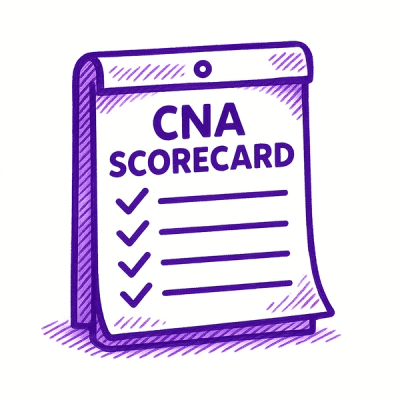
Security News
npm Adopts OIDC for Trusted Publishing in CI/CD Workflows
npm now supports Trusted Publishing with OIDC, enabling secure package publishing directly from CI/CD workflows without relying on long-lived tokens.
calendar-date
Advanced tools
Immutable object to represent a calendar date with zero dependencies
A calendar date is a date without time information, e.g. "2020-01-01". This library provides an immutable object to represent and work with a calendar date.
There are a lot of date libraries in the javascript world, but there is currently no adequate support for representing a calendar date. Most SQL Databases like MySQL and PostgreSQL have a datatype for representing a date without time information.
Using the built-in date object for a calendar date poses a number of disadvantages:
new Date(2020, 0, 1) and new Date('2020-01-01') return different Date objects depending on your local timezone.
If you call toISOString() on both date objects based on a timezone of UTC+1 it would return 2019-12-31T23:00:00.000Z for the first and 2020-01-01T00:00:00.000Z for the second.Install with yarn or npm:
yarn add calendar-date
or
npm install calendar-date
You can construct a CalendarDate from a String YYYY-MM-DD according to ISO 8601 or the year, month and day values.
The following constructor calls return the same calendar date.
new CalendarDate('2020-01-01');
new CalendarDate(2020, 1, 1);
You can also get the current UTC CalendarDate, the current local CalendarDate based on the timezone of your local environment or a CalendarDate for a specific time zone with the static methods nowUTC, nowLocal and nowTimeZone.
CalendarDate.nowUTC();
CalendarDate.nowLocal();
CalendarDate.nowTimeZone('Europe/Berlin');
If you want to construct a CalendarDate from an existing Date object instead of the current Time you can use the static methods fromDateUTC, fromDateLocal and fromDateTimeZone.
const date = new Date();
CalendarDate.fromDateUTC(date);
CalendarDate.fromDateLocal(date);
CalendarDate.fromDateTimeZone(date, 'Europe/Berlin');
The year, month, day and unix timestamp can be accessed as read-only properties on the object. Since version 2 of calendar-date the month value is now in the range of 1 to 12 and not of 0 to 11 anymore.
To compare to CalendarDate objects you can use the equals, isBefore, isAfter, isBeforeOrEqual and isAfterOrEqual
function or>=, <=, > and < operators.
The comparison works based on the unix timestamp.
const date1 = new CalendarDate('2020-01-01');
const date2 = new CalendarDate('2020-01-01');
const date3 = new CalendarDate('2020-02-02');
date1.equals(date2) // true
date1 === date2 // false
date1.equals(date3) // false
date1.isBefore(date3) // true
date1.isAfter(date3) // false
date1.isBeforeOrEqual(date2) // true
date1.isAfterOrEqual(date2) // false
date1 >= date2 // true
date1 > date2 // false
date1 >= date3 // false
date1 <= date3 // true
Returns true if the CalendarDate is in the same year as the other CalendarDate.
new CalendarDate('2020-01-01').isSameYear(new CalendarDate('2020-12-31')); // true
new CalendarDate('2020-01-01').isSameYear(new CalendarDate('2021-01-01')); // false
Returns true if the CalendarDate is in the same month and year as the other CalendarDate.
new CalendarDate('2020-01-01').isSameMonth(new CalendarDate('2020-01-15')); // true
new CalendarDate('2020-01-01').isSameMonth(new CalendarDate('2020-02-01')); // false
new CalendarDate('2020-01-01').isSameMonth(new CalendarDate('2021-01-01')); // false
Returns a new CalendarDate with the specified amount of months or days added.
new CalendarDate('2020-01-01').addMonths(3); // 2020-03-01
new CalendarDate('2020-01-01').addDays(15); // 2020-01-16
Returns a new CalendarDate with the first or last day of the month.
new CalendarDate('2020-01-15').getFirstDayOfMonth(); // 2020-01-01
new CalendarDate('2020-01-15').getLastDayOfMonth(); // 2020-01-31
Returns true if the CalendarDate is the first day of the month / last day of the month;
new CalendarDate('2020-01-15').isFirstDayOfMonth(); // false
new CalendarDate('2020-01-01').isFirstDayOfMonth(); // true
new CalendarDate('2020-01-30').isLastDayOfMonth(); // false
new CalendarDate('2020-01-31').isLastDayOfMonth(); // true
Returns the difference in days between to CalendarDate objects.
It will subtract the input date from the base date. If you supply the optional absolute parameter it will always return a positive value.
const date1 = new CalendarDate('2020-01-01');
const date2 = new CalendarDate('2020-02-01');
date1.getDifferenceInDays(date2); // -31
date1.getDifferenceInDays(date2, true); // 31
Returns the max/min CalendarDate for an array of CalendarDates.
const date1 = new CalendarDate('2020-01-01');
const date2 = new CalendarDate('2020-06-10');
const date3 = new CalendarDate('2021-03-15');
const maxDate = CalendarDate.max(date1, date2, date3); // 2021-03-15
const minDate = CalendarDate.min(date1, date2, date3); // 2020-01-01
Returns a sorted copy of an array of CalendarDates.
const sortedArrayAscending = CalendarDate.sortAscending([new CalendarDate('2020-01-01'), new CalendarDate('2020-06-10'), new CalendarDate('2021-03-15')]);
const sortedArrayDescending = CalendarDate.sortDescending([new CalendarDate('2020-01-01'), new CalendarDate('2020-06-10'), new CalendarDate('2021-03-15')]);
Returns the formatted string based on a provided pattern.
const date = new CalendarDate('2020-06-01');
date.toFormat('dd.MM.yy'); // 01.06.20
date.toFormat('d-M-yy'); // 1.6.20
date.toFormat('yyyy/dd/MM'); // 2020/01/06
You can also supply a locale and options object from the Intl DateTimeFormat Api.
const date = new CalendarDate('2020-06-01');
date.toFormat('en', { year: 'numeric', month: 'numeric', day: 'numeric' }); // 6/1/2020
date.toFormat('en', { weekday: 'long', month: 'short', day: 'numeric' }); // Monday, Jun 1
You can access the week of year according to ISO 8601 as a read only property on the calendar date object.
new CalendarDate('2023-01-01').week; // 52 (of year 2022)
new CalendarDate('2023-01-01').week; // 1 (of year 2023)
You can access the weekday according to ISO 8601 as a read only property on the calendar date object. The values are in the range from 1 to 7 starting from Monday.
new CalendarDate('2020-01-13').weekday; // 1 (Monday)
new CalendarDate('2020-01-19').weekday; // 7 (Sunday)
Returns a new CalendarDate with the first or last day of the week.
new CalendarDate('2020-01-15').getFirstDayOfWeek(); // 2020-01-13 (Monday)
new CalendarDate('2020-01-15').getLastDayOfWeek(); // 2020-01-19 (Friday)
Returns true if the CalendarDate is the first day of the week / last day of the week;
You need two CalendarDate objects to construct a new CalendarDateRange.
The first CalendarDate needs to be before or equal to the second CalendarDate.
If you set the optional autoArrange to true the constructor will determine the correct order of the passed CalendarDates.
const start = new CalendarDate('2020-01-01');
const end = new CalendarDate('2020-12-31');
new CalendarDateRange(start, end);
// OR
new CalendarDateRange(end, start, true);
// This will throw an error
new CalendarDateRange(end, start)
You can also parse a CalendarDateRange from a String representation with the format YYYY-MM-DD/YYYY-MM-DD:
CalendarDateRange.parse('2020-01-01/2020-12-31');
Start and end CalendarDates can be accessed as read-only properties on the object.
To compare a CalendarDateRange you can use the equals method.
It will return true if the start and end date represent the same CalendarDate for both CalendarDateRange objects.
Can be used to check if a CalendarDateRange or a CalendarDate is included in the Interval defined by the base CalendarDateRange. By default, start and end CalendarDates are included in the calculation, but you can omit them with the options parameter:
const date1 = new CalendarDate('2020-01-01');
const date2 = new CalendarDate('2020-02-01');
const date3 = new CalendarDate('2020-03-01');
const dateRange = new CalendarDateRange(date1, date3);
dateRange.includes(date1); // true
dateRange.includes(date1, { excludeStart: true}); // false
dateRange.includes(date2); // true
dateRange.includes(date2, { excludeEnd: true}); // false
dateRange.includes(date3); // true
Returns the total amount of days in the CalendarDateRange, including the start and end date.
const date1 = new CalendarDate('2020-01-01');
const date2 = new CalendarDate('2020-01-02');
new CalendarDateRange(date1, date2).getDifferenceInDays(); // 2
Returns the difference in days between start and end of the CalendarDateRange.
const date1 = new CalendarDate('2020-01-01');
const date2 = new CalendarDate('2020-02-01');
new CalendarDateRange(date1, date2).getDifferenceInDays(); // 31
Returns the difference in months between start and end of the CalendarDateRange as an integer, ignoring the day values.
const date1 = new CalendarDate('2020-05-15');
const date2 = new CalendarDate('2022-02-01');
new CalendarDateRange(date1, date2).getDifferenceInMonths(); // 21
For an array of CalendarDateRanges it returns true if there is an overlap between a range and one of its neighbours. Values will be sorted.
import { CalendarDateRange } from './CalendarDateRange';
const dateRange1 = new CalendarDateRange(new CalendarDate('2020-01-01'), new CalendarDate('2020-12-31'));
const dateRange2 = new CalendarDateRange(new CalendarDate('2020-06-01'), new CalendarDate('2021-06-01'));
const dateRange3 = new CalendarDateRange(new CalendarDate('2021-01-01'), new CalendarDate('2021-12-31'));
CalendarDateRange.hasOverlap([dateRange1, dateRange2]); // true
CalendarDateRange.hasOverlap([dateRange1, dateRange3]); // false
For an array of CalendarDateRanges it returns true if there is a gap between a range and one of its neighbours. Values will be sorted.
import { CalendarDateRange } from './CalendarDateRange';
const dateRange1 = new CalendarDateRange(new CalendarDate('2020-01-01'), new CalendarDate('2020-12-31'));
const dateRange2 = new CalendarDateRange(new CalendarDate('2020-06-01'), new CalendarDate('2021-06-01'));
const dateRange3 = new CalendarDateRange(new CalendarDate('2021-01-01'), new CalendarDate('2021-12-31'));
const dateRange4 = new CalendarDateRange(new CalendarDate('2021-01-02'), new CalendarDate('2021-12-31'));
CalendarDateRange.hasGap([dateRange1, dateRange2]); // false
CalendarDateRange.hasGap([dateRange1, dateRange3]); // false
CalendarDateRange.hasGap([dateRange1, dateRange4]); // true
If you want to upgrade from v1 to v2 of calendar-date you need to check if you access the read only month property on the calendar date object or use the number constructor anywhere and change the code according to the change (Range of month changed from 0-11 to 1-12). All other functions and properties work the same as before.
This project is licensed under the MIT License.
FAQs
Immutable object to represent a calendar date with zero dependencies
The npm package calendar-date receives a total of 9,177 weekly downloads. As such, calendar-date popularity was classified as popular.
We found that calendar-date demonstrated a healthy version release cadence and project activity because the last version was released less than a year ago. It has 2 open source maintainers collaborating on the project.
Did you know?

Socket for GitHub automatically highlights issues in each pull request and monitors the health of all your open source dependencies. Discover the contents of your packages and block harmful activity before you install or update your dependencies.

Security News
npm now supports Trusted Publishing with OIDC, enabling secure package publishing directly from CI/CD workflows without relying on long-lived tokens.

Research
/Security News
A RubyGems malware campaign used 60 malicious packages posing as automation tools to steal credentials from social media and marketing tool users.

Security News
The CNA Scorecard ranks CVE issuers by data completeness, revealing major gaps in patch info and software identifiers across thousands of vulnerabilities.